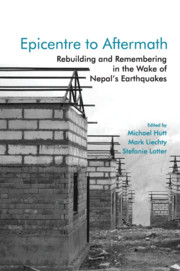11 - Kathmandu Durbar Square: Heritage Reconstruction as a Political Process of Negotiating Ownership and Authority
Published online by Cambridge University Press: 08 July 2021
Summary
The modern disaster is anything but natural in its constitution; it is a deeply political, moral, and cultural phenomenon.
—Kristian Cedervall Lauta (2018: 43)Introduction
In order to understand a disaster, we must study differences between its preconditions (Oliver-Smith and Hoffman 1999: 4) and its aftermath, along political, ethical, and cultural lines. Since the 2015 earthquakes, heritage preservation in multicultural Kathmandu has emerged as a discursive space in which political, ethical, and cultural issues such as claims to the ownership of sites and authority over the past are navigated. This chapter concentrates on the re-negotiation of power relations in a single site: the centrally located temple district and former royal palace of Hanuman Dhoka, technically known as the Kathmandu Durbar Square Protected Monument Zone. With a diameter of approximately 300 metres, the site offers a microcosm of Kathmandu's heritage negotiations involving an array of local, national, and international stakeholders. The examples chosen for the purposes of this discussion indicate a paradigm shift: the authoritative government-led approach established in 2016 was challenged by a community-led participatory approach in 2019. As such, this research constitutes a critical heritage study which contributes to our understanding of the political and ethical factors at play in the disaster aftermath.
The temples and palace courtyards that constitute the Kathmandu Durbar Square Protected Monument Zone were built between the 7th and 19th centuries, with the majority of the monuments dating from the 17th century. These were severely damaged by the 2015 earthquakes which reduced many of them to little more than a plinth or a set of foundations. In the immediate aftermath, when all hopes of finding any more survivors had died, several things happened simultaneously. Using heavy machinery, the Kathmandu Metropolitan City (KMC) removed what it considered to be merely ‘rubble’ at the time, in order to reduce hazards and clear public space. Meanwhile, citizens became volunteers, working together with the military and the police to guard the area and to retrieve and secure wood, stone, and metal elements from the temple sites. This was the moment when future political leaders were identified amongst those who volunteered, and territorial boundaries were established by fencing and locking up heritage sites.
- Type
- Chapter
- Information
- Epicentre to AftermathRebuilding and Remembering in the Wake of Nepal's Earthquakes, pp. 253 - 278Publisher: Cambridge University PressPrint publication year: 2021
- 1
- Cited by



